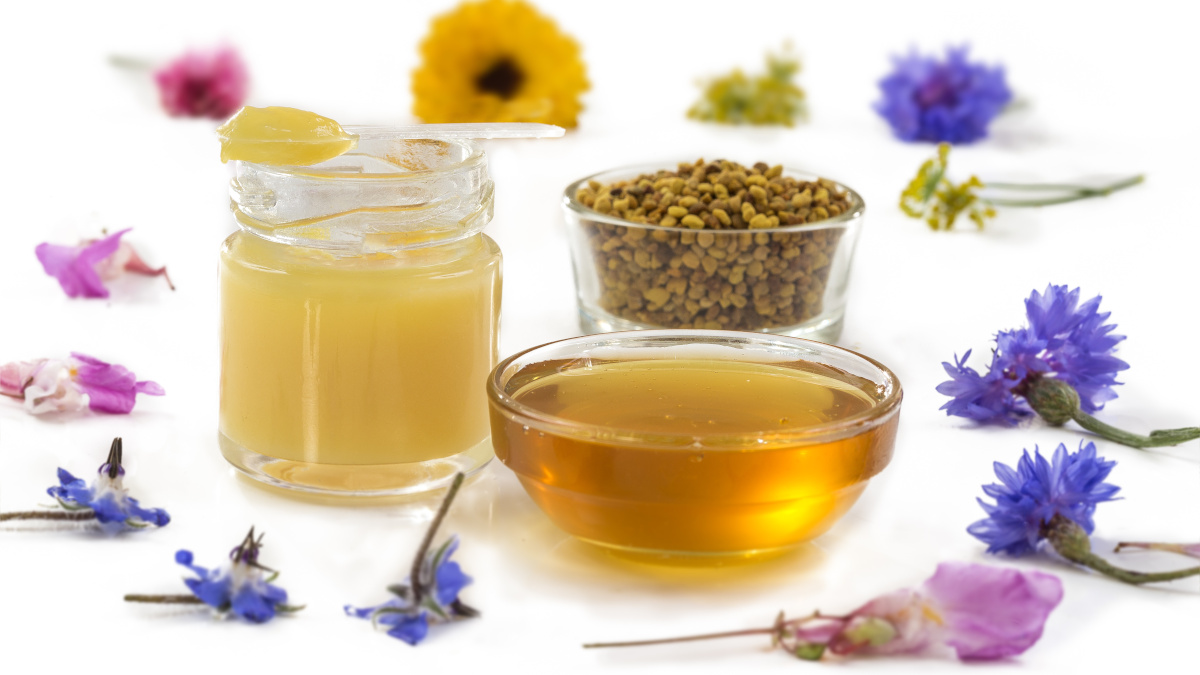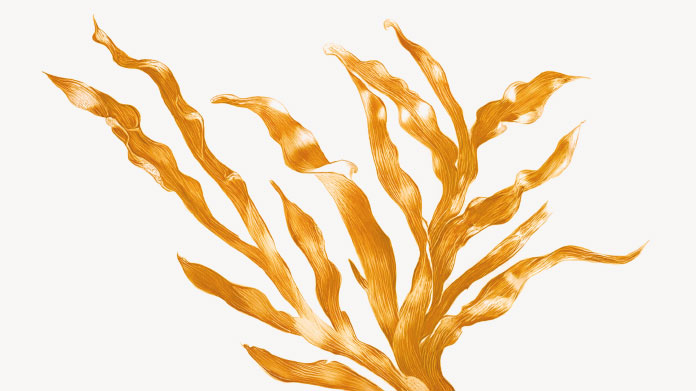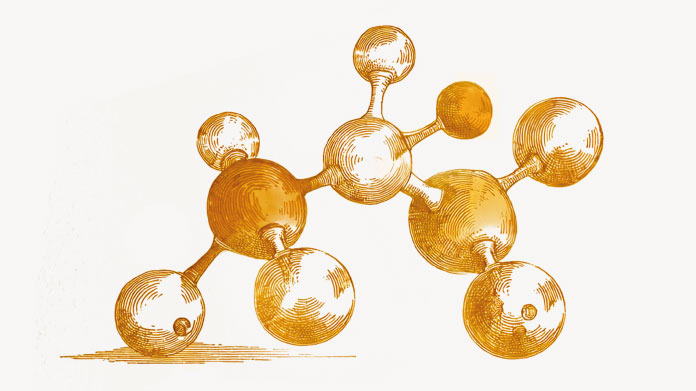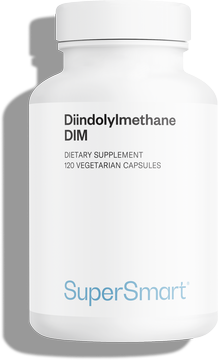
Origin and properties of honey
If humans have always looked after bees, it’s because they’ve always known how to benefit from the various treasures of the beehive.
The first of these is honey, a substance that’s sweet, viscous, and usually amber in colour. Produced by by worker bees from the nectar of flowers and honeydew from aphids, honey’s composition is 79.5% carbohydrates and 17% water, plus a number of trace-elements. It is the principal food made by bees.
In ancient times, the Egyptians would offer this nutritious food to their gods as well as using it to make mead or honey wine, sweeten their dishes and treat various ailments (1-2). The Greek philosopher Hippocrates, the father of Western medicine, considered honey a remedy; the physician and botanist Dioscorides described its medical and dietary uses. Many people like to add a spoonful of honey to their tea to soothe the throat.
But it was only in the mid-20th century, with the work of the biologist Belvefer, that another beehive product with amazing properties became very popular: royal jelly (3).
Royal jelly: the extraordinary food of the queen bee
Secreted by the worker bees’ hypopharyngeal glands, royal jelly is a bitter substance, pale yellow and pearly in appearance, produced to feed larvae as they grow, and above all, to nourish the queen bee.
Indeed, the queen of the beehive will be fed exclusively on this aptly-named jelly throughout her life. It is responsible for her considerable growth, longevity and robustness (4).
The composition of royal jelly is typically:
- 50%-65% water, 13%-18% proteins;
- 15% carbohydrates (primarily fructose and glucose);
- essential amino acids (valine, lysine, threonine, leucine, isoleucine, tryptophan, phenylalanine, methionine);
- minerals and trace-elements (calcium, silicon, magnesium, sulphur, potassium, phosphorus, copper, iron, in particular);
- vitamins (B1, B2, B3, B5 and B9) ;
- acetylcholine (a neurotransmitter involved in the function of the central nervous system) ;
- 3%-5% lipids (5).
Most importantly, however, royal jelly uniquely contains three particular molecules:
- 10-hydroxy-2-decenoic acid (10H2DA): a fatty acid which may be responsible for the queen’s longevity - she can live for 5 to 6 years as opposed to the average 60 day lifespan of a worker bee (6);
- royalisin: an amino acid with antimicrobial properties which may account for the queen’s robustness and ability to withstand external aggressors (7);
- royalactin, a protein which may be the key to the queen bee’s strong growth (8).
Longevity, growth and anti-microbial factors: these are the three main attractions of royal jelly for the beehive which have equally been generating scientific interest for more than 70 years.
The wealth of nutrients offered by this food, known also as Bee Milk », is also popular with humans now, especially for overcoming fatigue, stress or during convalescence.
How should royal jelly be consumed?
Rich and complex, royal jelly is meant to be consumed immediately by the queen bee and larvae in the hive, and is not designed to be stored.
It must therefore be protected from sunlight, heat and air in order to preserve all its properties. Fresh royal jelly should therefore always be kept refrigerated in a dark container, from the time it’s collected until it’s consumed.
In fact, one of the most common problems with royal jelly is the appearance of small bubbles in the pot of fresh jelly, indicating that fermentation has begun. And while we might like mead or honey wine, fermented royal jelly is not fit for human consumption.
It is precisely in order to make it easier to store, preserve and consume royal jelly that certain manufacturers have succeeded in freeze-drying it. It can thus be encapsulated and stored in the cupboard, like any other dietary supplement or spice (this is the case for the royal jelly supplementOrganic Royal jelly 4% 10-HDA, which is particularly rich in 10-HDA).
For products providing 100mg of royal jelly per capsule, the dose usually recommended is 2 capsules in the morning with breakfast, and possibly a 3rd capsule with lunch.
Alongside supplementation with royal jelly, we’d also suggest discovering the benefits of propolis, the other nutritional gem from the honeybee, produced by them to protect the hive from infections. Rather than the classic brown propolis, try to opt for either green propolis or red propolis, which are rarer but more potent.
References
- CILLIERS, Louise et RETIEF, François Petier. Bees, honey and health in antiquity. Akroterion, 2008, vol. 53, no 1, p. 7-19.
- FRADELOS, Evangelos. The therapeutic use of honey from Greek antiquity until today. Balkan Military Medical Review, 2013, vol. 16, no 4, p. 456-461.
- VIEL, Claude et DORÉ, Jean-Christophe. Histoire et emplois du miel, de l'hydromel et des produits de la ruche. Revue d'histoire de la pharmacie, 2003, vol. 91, no 337, p. 7-20.
- LECERF, Jean-Michel. Produits de la ruche. Phytothérapie, 2009, vol. 7, no 2, p. 73-74.
- BĂRNUŢIU, Lavinia Ioana, MĂRGHITAŞ, Liviu Al, DEZMIREAN, Daniel S., et al. Chemical composition and antimicrobial activity of Royal Jelly-REVIEW. Scientific Papers Animal Science and Biotechnologies, 2011, vol. 44, no 2, p. 67-72.
- SUGIYAMA, Tsuyoshi, TAKAHASHI, Keita, KUZUMAKI, Akihiro, et al. Inhibitory mechanism of 10-hydroxy-trans-2-decenoic acid (royal jelly acid) against lipopolysaccharide-and interf.-β-induced nitric oxide production. Inflammation, 2013, vol. 36, no 2, p. 372-378.
- FUJIWARA, Suguru, IMAI, Jiro, FUJIWARA, Mineko, et al. A potent antibacterial protein in royal jelly. Purification and determination of the primary structure of royalisin. Journal of biological chemistry, 1990, vol. 265, no 19, p. 11333-11337.
- KAMAKURA, Masaki. Royalactin induces queen differentiation in honeybees. Nature, 2011, vol. 473, no 7348, p. 478-483.
7 Hours
Good quality product and customer service.
So far, I'm liking this product, and the customer service was very good.
ELZL
7 Days
The products I use are excel·lent
The products I use are excel·lent
ROSAS Josep Maria
15 Days
Delivery is prompt and I never saw a…
Delivery is prompt and I never saw a quality problem with the manufacturing. It is not possible to assess efficacy on a personal basis, since too many factors come into play. Efficacy can only be assessed statistically with a sufficient number of cases.
Roger De Backer
16 Days
I collaborates with the Supersmart…
I collaborates with the Supersmart more than 10 years. Every thing is going good. Quality of the things is good. Delivery comes in time. Five stars definitely !!!
Oleksiy
16 Days
All good
Simple, frictionless site, easy ordering, good delivery updates and execution.
Chris Robbins
18 Days
I feel better
I feel better
Peter Ammann
18 Days
Prompt delivery
Prompt delivery
JAKUB Radisch
19 Days
My new go-to for top quality supplements!
I am buying more and more of my supplements from this superb, high quality company. Cannot recommend it enough. Plus, excellent customer service with a quick, helpful team and speedy deliveries. Highly recommend Supersmart!
Cecilie H.
23 Days
SUPERSMART WHAT ELSE👍
SUPERSMART WHAT ELSE👍
DIEDERLE Christophe
26 Days
Excellent quality products with…
Excellent quality products with innovative formulas, as someone who has been suffering with acid reflux, these supplements have been lifesavers.
Oriana Moniz
26 Days
high quality supplement!
high quality supplement!
GALANT
27 Days
Good service prompt delivery
Good service prompt delivery
Mrs Marcella Reeves
31 Days
I like your clear explanation
I like your clear explanation. And how to make a choice of products for a specific health problem
Ingrid
38 Days
Great product and it arrives quickly.
Great product and it arrives quickly.
SOMMARIVA Gianni
39 Days
Excellent products and fast service.
Excellent products and fast service. What do we need more?
Margarida





